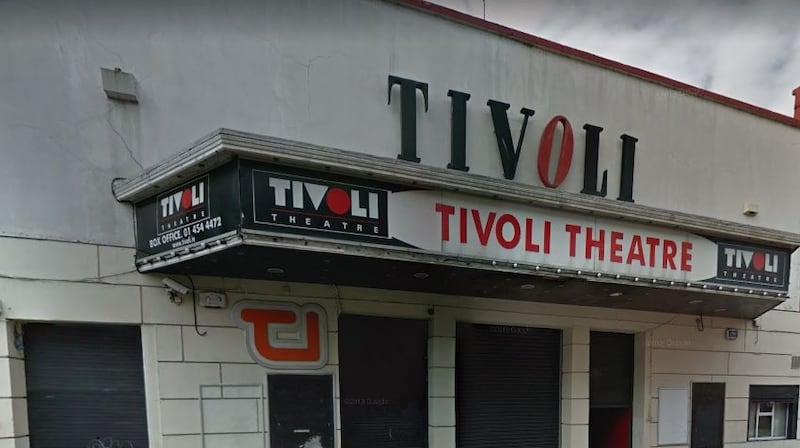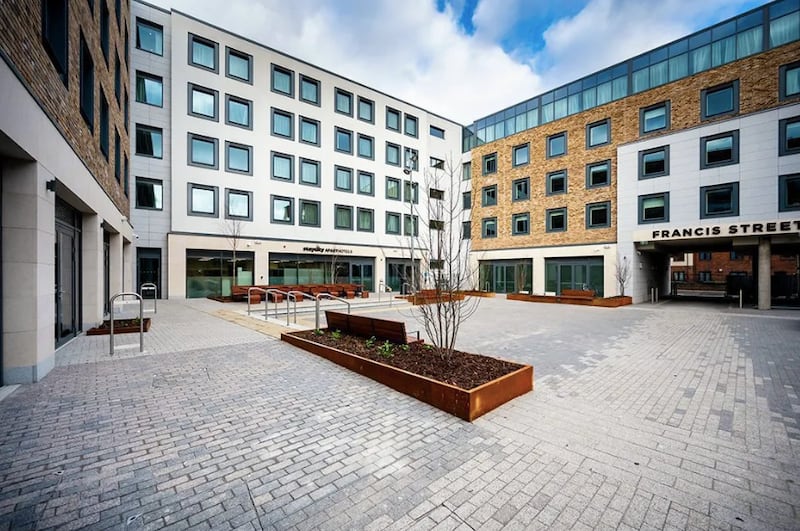In a design for a new civic square in Dublin’s Liberties, the architecture firm Douglas Wallace explains on their website that its name is “in honour of the existing theatre which forms part of the site”. The Tivoli refers to a building that was a theatre for 32 years (and a cinema during earlier decades) and now an aparthotel development.
“Tivoli Place”, the scheme containing the square, is owned by the German asset management company DWS, in partnership with aparthotel operators StayCity. The name sounds like a nod to the neighbourhood’s rich cultural past, and easily invokes memories of the demolished theatre – of countless club nights, wrestling events, comedy shows, plays, pantomimes and street art. Now, according to StayCity’s website, it promises “stylish” studios for guests staying on “eclectic Francis Street”. The Liberties is described as “fast becoming Dublin’s hippest neighbourhood. Surrounded by a medley of antique shops, vintage boutiques, art galleries, bars and cafes, this is where old Dublin meets new.”
That “new” Dublin looks increasingly in thrall to privately owned spaces rather than centres of community. “Wherever there is a scrap piece of land available, developers are in, and they seem insistent on making it a hotel district,” says Maurice O’Connell, a manager at South Inner City Community Development Association (SICCDA), which organises the Liberties Festival. The Tivoli Theatre had been a venue for the festival, and in recent years hosted performances by comic Eric Lalor and cabaret artist David Hoyle.
O’Connell emphasises that the Liberties gets its energy from the people living there, and that the loss of cultural spaces will affect the local mood. “The absence of Tivoli is symbolic of the lack of resources in the area for the people. It’s a symbol of how people feel that they’re being forgotten,” he says.
RM Block

For some, the development’s PR campaign is the kind that grinds. In other jurisdictions, similar campaigns have, in attempting to rebrand a neighbourhood, used creative expressions of local culture as a tool. In his book Vanishing New York, a cogent account of gentrification in that city, the writer Griffin Hansbury gives an overview of absurd events in 2015, when a wealthy group of real estate developers erected a billboard renaming the South Bronx the “Piano District” – a reference to a past era when the neighbourhood was filled with piano factories. Ironically, what was once a centre of industrialisation and blue-collar work was to be replaced by schemes promising “luxury waterfront living, world-class dining, fashion, art + architecture”.
There is a lot of currency in a name. Veronica Dyas, a theatre artist from the Liberties, agrees that the evocation of the Tivoli Theatre is a specific kind of marketing strategy, an attempt to add the theatre’s legend to the development’s myth. “It is co-opting our culture and marketing it back at extortionate prices,” she says.
In 2018, Dyas’s excellent play My Son My Son – a touching drama about a tireless volunteer in the Liberties – showed a community wary of the current wave of hypergentrification. Looking back, it felt like an early warning. (Dyas admits to feeling like she writes plays too fast – 2014′s Here & Now, an intimate telling of how she lost her home during the Great Recession, arrived before any mention of the homelessness crisis.)
One scene in My Son My Son finds two local women talking to each other on a street who are interrupted by an abrupt tourist asking for directions. Preferring to speak in private, the friends step inside the Meath Street Grotto, a secret garden that Dyas calls the heart of the Liberties. That moment in the play now feels prescient. Last year, a different hotel development proposed to extend to the boundary walls of the garden, triggering an outcry and a campaign to halt its progress.
On a recent visit to Tivoli Place, the quiet parking lot contrasted with the architects’ designs for a lively civic square with an abundance of outdoor seating and a crowd of people watching a performance by musicians on a stage. In reality, a new performance arts facility on the edge of the square sat closed, with hotel equipment stored inside. Around the corner, a stretch of the prestigious graffiti wall from the Tivoli Theatre was preserved, and partially blocked behind bins and a bike rack.
With the possibility that the Tivoli Theatre’s stylish sign could be installed onsite (the memorabilia collectors Rare Irish Stuff, who purchased the sign at auction, express interest on their website in returning it to the theatre’s location), a destination rich with cultural activity seems to be only a promise. In June a planning application by Cantarini Limited, a company connected to StayCity, was made to Dublin City Council, proposing to erect a gate that would control access to the square.

“Tivoli Place was supposed to be a place that joined up different parts of the Liberties, rather than somewhere that is closed off for visitors,” says O’Connell, who, as part of SICCDA, has lodged an objection to the planning application.
“If you’re going to pretend that everything is the same without the Tivoli Theatre, without actually making something cultural available to people – whether it was to use the square or to use the performance space to provide theatre or classes – then the local people get more and more cynical. They’re not being heard,” he says.
A statement from a StayCity spokesperson – explaining that the function of the gate is to prevent anti-social behaviour – has been received with suspicion. “Gated community ideology creates anti-social behaviour,” says Dyas.
“It segregates. What it says is: ‘We’re better than you.’ It says: ‘We have stuff in here you can’t have.’ Automatically, it’s creating a friction between two groups of people who didn’t have friction to begin with.”
If the development’s priorities so far relate only to how to close the space, when there is yet to be any programme of cultural events, these moves could be viewed with scepticism. That mightn’t be an easy heel-turn. Unlike the “Piano District” developers who could make reference to South Bronx culture in name alone, Tivoli Place had a function as a cultural venue written into its planning permission.
In 2017, an application by Tivoli Theatre owner Anthony Byrne to demolish the theatre and build a 289-bed aparthotel, restaurant and gym was refused after concerns were raised about the loss of a major cultural facility. Byrne’s subsequent application addressed those worries, and resulted in a development that hitches an aparthotel to the legacy of a former theatre.
That included designs for a “Tivoli Performance & Arts Centre” to “allow for the Tivoli to be reborn on this site as a flexible performance and arts space for use by the wider arts and performance community”. Outside, on the square, a “raised stage area” will be used for “performance shows & cinematic screenings”. The centre will be an “innovative and exciting multifaceted cultural facility for the Liberties Area and Dublin City”.
A statement by Douglas Wallace Architects, included in the application, says that Byrne will “operate this proposed new facility”.
O’Connell says the Liberties Festival would have tried to programme events at the Tivoli Theatre if it were still around. “The argument for closing the theatre was that it was too small. We are now looking for smaller venues. We are looking for a space for a children’s talent competition. Huge venues are no good for them,” he says.
Reflecting on the city’s priorities, Dyas compares the swift completion of Tivoli Place with the 30-year dereliction of the Iveagh Markets on the same street. She is alive to the tensions that can arise when local inhabitants aren’t provided the public space they need. “That’s how resentment builds, and how division happens and maintains. It doesn’t come out of anywhere” she says.
If the development has yet to reconcile its aparthotel business with its role as a public venue, then it may have considered the previous resident on the site in the past tense only. Tivoli, it turns out, still refers to a building for culture.















